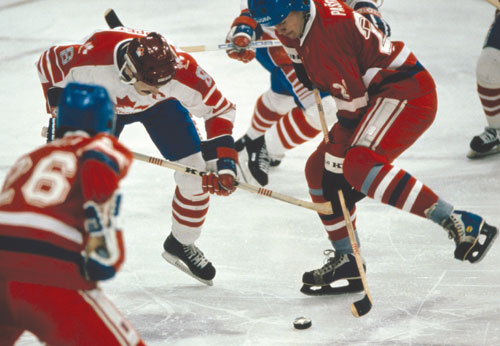The Language Playing Field
By Fenella Saunders
To improve your communication abilities, try taking up hockey
To improve your communication abilities, try taking up hockey

DOI: 10.1511/2008.75.462
When a hockey player hits the ice, practicing his skills until they are second nature, he's probably not aware that he's also improving his language cognition aptitude. Experience doing an activity, such as playing hockey, may allow the brain to recruit areas that are usually devoted to skilled action to the task of comprehending speech, particularly when the words relate to the activity in question. And the phenomenon holds not only for players, but also for fans who have experience watching the sport but none playing it.

JTB Photo Communications, Inc./Alamy
Sian Beilock, a psychologist at the University of Chicago, and her colleagues gathered a group of hockey players from college and minor-league teams, as well as avid fans and "novices" with no hockey experience whatsoever. The participants underwent a magnetic resonance imaging (MRI) scan while they passively listened to a set of sentences that related either to everyday activities ("The individual pushed the cart") or hockey actions ("The hockey player saved the shot"). The researchers recorded which areas of the brain the sentences activated in the three groups of participants.
After the scan, the participants heard the same sentences again, but this time they were asked to perform a matching task: After each sentence, they were shown a picture and selected, as quickly as possible, whether or not the illustration showed the action being described in the sentence.
Previous research has established that responses should be faster when the picture matches the sentence. "The idea is that if you understand the sentence better, then you should be better at discriminating between people performing actions that match versus people performing actions that don't," Beilock explains. This result was true of all the participants for the everyday actions. But for the hockey-related sentences, only players and fans showed the effect.
Looking at the MRI scans, Beilock and her colleagues were able to account for the increased comprehension of hockey-related sentences in players and fans. Those two groups showed activation in the part of the brain called the left dorsal premotor cortex, an area that lights up as a person plans to perform a well-learned action—and not usually a brain region implicated in language comprehension.
"Everyone really can understand the sentences at some level, but what we're showing is that a deeper understanding seems to arise from experiencing and doing the action described in the sentence," Beilock says. "We think that a better comprehension arises because those people with those experiences are essentially relying on areas of the brain involved in ‘doing' when they're just listening to the language."
Fans look a lot like experts in terms of how they activate these brain regions. "So just having some seeing experience seems to sort of rev up the ‘doing' system," Beilock says. "We think that active mental picture involves some motor plan to act, which is really neat considering that they've never acted in that way."
In contrast, novices' brains instead showed activation in an area used for more general-purpose movement. "Novices don't have plans in their motor skill repertoire to act on the actions they've heard, either through seeing or doing," says Beilock. "But they may still be trying to understand the sentences in a sense through embodying the action, so they seem to call upon sensory-motor areas involved in simpler actions."
Fans' brains also showed activity in this second region, but players' brains did not. "It's almost as if our fans are activating extra stuff they don't need and are doing more work," Beilock says. "Even though they look like the experts in terms of their patterns of performance, the fans are slower at doing the comprehension task in general, not only than the experts but slower than the novices. And it's not just that our fans are drinking beer all the time because they don't look slow when responding to non-hockey sentences."
The results cannot be explained simply as fans having, say, a greater hockey vocabulary than novices, Beilock says: "By looking in the brain we can say it's not just merely abstract conceptual understanding, it has something to do with how those areas of the brain involved in selecting actions are more highly activated for these fans than for novices."
Beilock thinks this phenomenon is not specific to hockey or even to sports, but may be found across a wide range of experiences, such as playing or appreciating music. The results could also help explain why sometimes people remember things better when they act them out. "It may be that's because this acting out allows these people to call on these motor systems when they then have to remember," Beilock says.
Another implication is that adult language-processing mechanisms might not be so impervious to change as previously thought. It might be possible to alter these systems with activities completely unrelated to language.
Beilock also suggests that students could benefit from a more active experience in learning subjects with action components, such as physics or math. "Rather than having kids at a desk," she says, "getting them about and moving and experiencing some of the concepts they're going to learn about, such as momentum, may actually help jump-start their comprehension when it comes time to read about it in the textbook."
Click "American Scientist" to access home page
American Scientist Comments and Discussion
To discuss our articles or comment on them, please share them and tag American Scientist on social media platforms. Here are links to our profiles on Twitter, Facebook, and LinkedIn.
If we re-share your post, we will moderate comments/discussion following our comments policy.